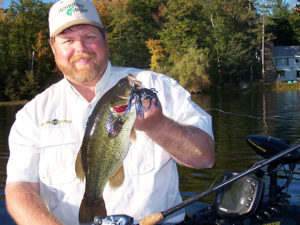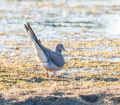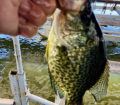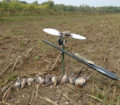By Bob Jensen
Fishing the Midwest Fishing Team

(photo by Bob Jensen) A nice one but not a big one. This Wisconsin largemouth wanted a bulky bait fished slowly one autumn day several years ago.
The leaves on the trees are changing colors and the kids are back in school. The first few flocks of early migrating ducks are starting to show up. The people who hunt ducks are practicing calling and are checking their ammunition supply. And the people who like to catch lots of fish and big fish are putting fresh line on their reels.
They know that the best time of year to be on the water in search of big fish starts now and goes until the surface of the water turns to ice. Walleye, bass, musky, crappie, and a variety of other fish are out there waiting to be caught. Here’s how you can increase your chances of helping them get caught.
Keep in mind that different bodies of water will be productive in the fall at different times. A shallow lake with dark water will often be better earlier in the fall, while larger, deeper lakes with clear water will get better for fishing a little later in the year.
Small shallow lakes cool off earlier, so the fish in those lakes are reminded by Mother Nature that autumn is coming and they need to fatten up. This reminder comes later to fish in the larger, deeper lakes. Rivers will continue to provide great open water fishing after the lakes in the area have frozen over.
As the water cools off, slower presentations will become more productive. Crankbaits can be good for walleyes early in the fall, and a jig/minnow or jig/plastic combination will get better as the water cools off. When I’m on big fish water, I’ll usually troll crankbaits like Lucky Shad, Bansai Shad, or Banana Shad depending on how deep the walleyes are running. The Lucky for water down to about ten feet, Bansai for mid-depths, and the Banana for deeper than fifteen feet. I’ll do this mostly in low-light conditions and at night.
During the day, do some sonar work looking for groups of walleyes near underwater structure. When you’ve located a school of what you think are walleyes, start with a jig/Rage Swimmer set-up. The jig/plastic will work much of the time, but there comes another time when there’s nothing better than a jig/minnow.
Very important reminder: If you locate a school of walleyes in deeper water, say over twenty five feet, don’t sit on them and catch fish after fish after fish. Many of them won’t survive if you release them. The pressure change from the bottom of the lake to the surface will turn them into bird food if they’re released. Catch enough for a meal, then find some shallower fish. It can be hard to leave biters, but it’s for the best.
The same presentation concept holds true with largemouth and smallmouth bass. Either of these will aggressively eat a faster moving bait early in the autumn, but as the water cools, largemouth will be more frequently caught on a rubber-legged jig and a piece of plastic. A bulky piece of plastic. A largemouth is going to have a hard time refusing a Denny Brauer Pro-Model Jig with a Rage Bug on the back.
If the body of water that you’re on is home to smallmouth bass, find a school of them, tie on a dropshot rig, and get ready to get bit. A good number of years ago smallmouth bass expert Barry Day showed me how to dropshot. On a day when other anglers were having a hard time getting a smallmouth to bite, Barry and I caught enough smallmouth along with some largemouth, walleyes, pike, and panfish to keep us more than happy, and they all came on dropshot rigs. Just remember that in the fall, slower presentations will often be better.
If you choose to do something other than go fishing in the fall, there’s nothing wrong with that. But if you decide to go fishing, and if you keep these ideas in mind, your odds of getting bit are pretty good. And, if you get a little bit lucky, that bite could be a really big fish. Keep warm, be safe, but go fishing in the fall.















